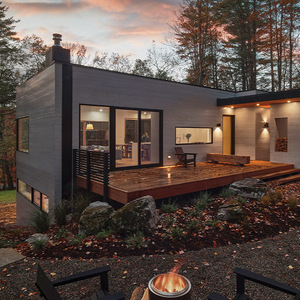I’ve got a problem I’m hoping I can get a few ideas on how to fix.
Am getting to the finish stages of a modest addition to my house. Doing the work myself and am not a carpenter/contractor by trade.
There is one interior wall that is perpendicular to the roof trusses. It is about 5’ from an outside wall. Where the trusses cross over the interior wall, there is about a half inch gap. I.e. the trusses don’t sit or touch the top plate of the interior wall.
My concern is with the wallboard for the ceiling. If I attach it to the roof trusses, it will end up even with the top of the interior wall on one side of the room, and about a half inch below the top of the opposite exterior wall. I’ve been told that the weight of the roof and drywall will pull the trusses bottom cord down. By the way, the trusses are attached to the interior wall with clips that allow for the bottom cord to move up and down. Will the weight of drywall pull the bottom cord down right away? If not, when installing the drywall on this interior wall, do I install the top edge of the drywall flush with bottom surface of the ceiling drywall?
I am worried that if I put the wall drywall up flush with ceiling and the bottom cord settles over time, I will have cracks or worse. I can’t see leaving a gap and hoping that the bottom cord settles over a few days. What if it doesn’t?
The only solution I could come up with, is to sister a 2×4 to each bottom cord that is level with the top of the interior and exterior walls, and attach the ceiling drywall to that. Will this cause a problem later, that I don’t currently anticipate?
Thanks in advance.



















Replies
Ottercove,
You're one of many who have to deal with "truss lift."
It's best to let the trusses float so they can travel as required. Some drywallers deal with the problem by not screwing the ceiling drywall to the truss chords within about 2" or so of the partition wall. this is supposed to allow the chord to float, and allow the drywall to flex as the chords move. Sometimes it works, sometimes it doesn't.
My preferred way would be to install crown molding in the room. First, screw the drywall to the ceilings and drywall to the walls as usual. Allow space so the truss chords can contact the cap plate of the partition wall without any drywall/drywall contact.
To prepare for the crown molding, use a backer behind the crown that is screwed to the bottom chords of the trusses. Do not fasten the backer to the wall in any way, shape, or form. Nail the crown to the backer. Ensure that the nails don't go through the backer and enter the drywall on the wall. Don't caulk the bottom of the crown to the wall. There should be no mechanical connection between the crown and the wall, the crown/backer should only be attached to the truss chords.
When the truss chords "lift", they'll lift the backer and crown with them. The crown will slide up and down at the top of the wall, like a slip joint, keeping the gap covered at all times. If the nails used to install the crown went into the drywall, you'll likely end up with little piles of drywall dust on your floor caused by the nails repeatedly scraping the drywall.
If this isn't clear I can fire off a few drawings to you.
Edited 6/13/2002 12:37:20 AM ET by Mongo
Mongo:
Thanks for your reply.
I believe I have a good grasp of the concept.
Do have a couple questions.
1) Is it a certainty that the trusses will move once they are bearing the weight of the drywall? If so, is it due to climate changes. We’re located on the central California coast, with a pretty mild climate. Does that make a difference?
2) I understand how the crown molding is supposed to work, but I’m not clear on the backer board. Crown molding typically runs at a 45 degree angle to the corner right? So how does the backer board attach to both the molding and the ceiling?
Thanks again.
Ottercove,
Truss lift seems o be somewhat of a mystery. I can;t promise that th weight of the drywall will lock the trusses dwn and prevent further movement. I can;t promise that this is a "new construction" thing and that once it moves the first time, it'll never budge again. I have heard where peoples trusses move every year, seasonally...but with Boss Hog being the truss man on this forum I'd bet he'd be able to give more succinct feedback..
The "backer board" can be done in a variety of ways:
Small triangles (red in my attachment) can be nailed to each truss chord to provide backing at each truss. You'd have to snap a line to keep all these pieces straight. The crown (yellow in my attachment) is then nailed to these triangles. I don't like this, as I'd prefer more stability between adjacent chords.
It depends on the size of the crown, but the method I prefer is to screw a long board (colored green in my attachment) perpendicular to the chords. The leading edge of this board can be beveled (45 degrees for 45 degree crown). Depending on the size of the crown, sometimes a beveled 2x4 will work. With larger crown you'll need a larger backer. I'd use 1-by stock with the leading edge beveled as required. To that, I'd screw trianglular-shaped cutoffs (red n the attachment, and again, 45 degrees, or as required by the angle of the crown) spaced every 16" or as required. the crown (yellow) gets fastened to this.
I prefer the full-length backer with triangles vs just having triangles screwed to each chord as it provides much more stability for the entire system.
Let's hope this attachment works out...
Edit: Attachment worked. I hope it will clarify things...with the exception of how to spell "partition". Oops.<g>
Edited 6/13/2002 7:42:07 PM ET by Mongo
Once again thanks for the help.
I got the attachement just fine and I have a clear picture of what you mean.
Seems like a lot of work, but I want to be right.
If you were not planning on installing crown, it's definitely added work. If you were already intending to fully trim out the room, it's really not that bad.
I rip the bevel on the backer, then screw the triangles in place, screwing through the "top" of the backer and into the triangle. Then I screw the backer/triangle assembly to the trusses.
Realize that this only needs to be done on the wall(s) suffering from truss lift.
Regardless of which method you use, I hope you';re able to find a durable and aesthetically pleasing remedy. Best of luck!
Download this document and look at the second page. It has some drawings showing how to drywall to allow for truss uplift. (They call it "Partition Separation")
Your ridiculous little opinion has been noted.
click here for the wtca URL to see in a PDF window - but this is a non-printable document.T. Jeffery Clarke
Quidvis Recte Factum Quamvis Humile Praeclarum
Thanks for the pdf file.
I will look it over.